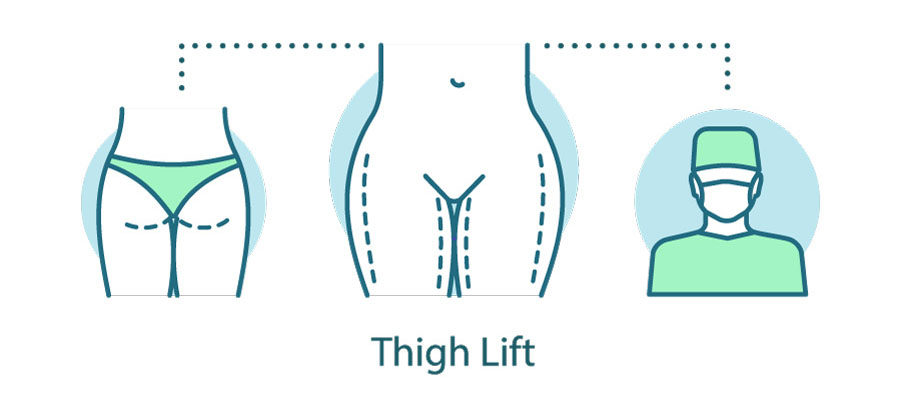
For the bariatric patient, the inner thigh lift is a popular operation because excessive skin of the medial thighs can lead to functional impairment, frequent cutaneous infections and rash, and mental distress. Historically, this operation has been associated with a high complication rate, and many plastic surgeons shy away from performing thigh lift at all in clinical practice. However, knowledge and innovation in thigh lift can reduce complications and improve patient satisfaction at lower risks.
For patients to be successful with thigh lift surgery, we recommend patients choose plastic surgeons with an interest in thigh lift surgery and body contouring after major weight loss. Second, be sure your chosen plastic surgeon can demonstrate good outcomes by showing you plenty of before and after thigh lift surgery results. To see our results, Click Here. Third and most important, your surgeon should demonstrate a good understanding of the techniques they plan to use for your thigh lift surgery and be able to communicate that clearly to you.
Our approach to medial thigh lift at Guerra Plastic Surgery Center.
First, we classify patients demonstrating concerns about their thighs into three groups:
Type 1: The non-deflated type. Typically, the inner thighs demonstrate minimal or no skin laxity and are full of fatty volume. These patients are usually better served with liposuction alone and a formal thigh skin resection is often not required or delayed until the patient loses additional weight.
Type 2: The mixed type. In these cases, patients typically have a combination of moderate fatty volume deposits and moderate skin laxity. Depending on the clinical findings at examination, these patients can be good candidates for a medial thigh lift.
Type 3: The deflated type. These patients demonstrate little fatty volume deposits in the inner thighs in combination with a considerable amount of excess skin. These patients are considered ideal candidates for bi-directional medial thigh lift.
Most of our operations will be on type 3 individuals with some type 2 thighs. We begin the process with an assessment of the nutritional state and overall health of our patients. Patients with nutritional deficiencies and/or anemia are treated accordingly, and surgery is scheduled when these issues have been optimized.
We then educate patients on the most important steps with our thigh lift technique, which include: Vector of directional pull of the tight lift, the Avoidance of high bacterial counts by placement of incisions away from genitalia, Liposuction to precede the actual excess skin removal, which then preserves the microvascular blood vessel sUpply, nErves, lymphatic system, and leads to the avoidance of drains.
We call this the VALUE technique. Let’s learn more about the rationale behind this approach.
The Vector: A single vertical direction of pull has been tried by plastic surgeons in the past and results in several problems. These include vulvar distortion, scar migration, and high postoperative pain. To avoid most of these complications, we recommend a bi-directional vector of pull which includes a vertical as well as a horizontal component.
Bacterial count: The closer the incisions are located to the genitalia, the higher the bacterial count, and even with the administration of powerful antibiotics, the risks of infection can increase. We recommend placing the incision lines away from the genitalia, but still in an acceptable and hidden location between the thighs. This approach also limits scar migration. Additionally, we recommend a special dressing of protective barrier which is glued into place and keeps moisture and bacteria away from the skin incision.
Liposuction before thigh lift: This is the most important of all the steps. Liposuction allows for the preservation of the microvasculature, as well as nerves, lymphatic system, and the Saphenous vein. Since no empty space is left after the skin resection, there is no need for a drain and patients typically experience a more comfortable overall postoperative course with less swelling and lower overall risks.
For more details about medial thigh lift after major weight loss, we strongly suggest a full consultation with Dr. Aldo Guerra. If you’re interested in a medial thigh lift click here or call our Scottsdale office at (480) 382-4995.


